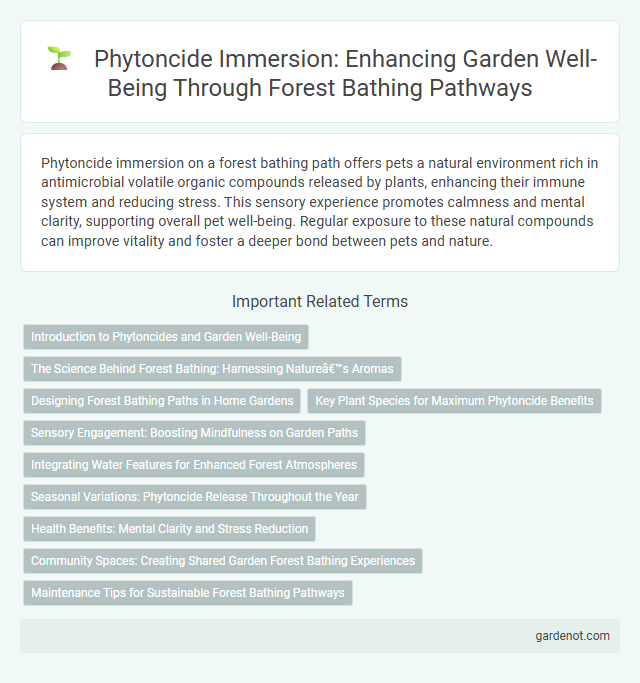Phytoncide immersion on a forest bathing path offers pets a natural environment rich in antimicrobial volatile organic compounds released by plants, enhancing their immune system and reducing stress. This sensory experience promotes calmness and mental clarity, supporting overall pet well-being. Regular exposure to these natural compounds can improve vitality and foster a deeper bond between pets and nature.
Introduction to Phytoncides and Garden Well-Being
Phytoncides, natural antimicrobial compounds emitted by trees and plants, play a crucial role in enhancing garden well-being by reducing stress and boosting immune function during forest bathing. Immersion in environments rich in phytoncides, such as pine and cedar forests, promotes relaxation, lowers blood pressure, and elevates mood. Experiencing these beneficial organic substances supports mental clarity and overall health, making phytoncide-rich paths an essential aspect of holistic nature therapy.
The Science Behind Forest Bathing: Harnessing Nature’s Aromas
Phytoncides, natural antimicrobial compounds emitted by trees, play a key role in forest bathing by enhancing immune function and reducing stress hormones when inhaled. Scientific studies demonstrate that exposure to these volatile organic compounds boosts natural killer cell activity, which helps the body combat infections and cancer. Immersing in forest environments rich in phytoncides triggers physiological benefits such as lowered blood pressure and improved mood through the inhalation of nature's aromas.
Designing Forest Bathing Paths in Home Gardens
Designing forest bathing paths in home gardens emphasizes phytoncide immersion by strategically incorporating native trees and shrubs that emit these natural antimicrobial volatile organic compounds. Integrating varied plant species with high phytoncide output, such as cedar, cypress, and pine, enhances the therapeutic atmosphere and promotes respiratory health. Creating winding trails with textured ground cover and shaded areas maximizes sensory engagement and fosters deep relaxation through consistent exposure to forest-derived biochemicals.
Key Plant Species for Maximum Phytoncide Benefits
Key plant species such as Japanese cedar (Cryptomeria japonica), hinoki cypress (Chamaecyparis obtusa), and pine trees (Pinus spp.) emit high concentrations of phytoncides, essential for enhancing immune function and reducing stress during forest bathing. These plants release volatile organic compounds like alpha-pinene and limonene, which strengthen natural killer cell activity and promote relaxation. Immersing in areas dense with these species maximizes phytoncide exposure, amplifying both physical and mental health benefits.
Sensory Engagement: Boosting Mindfulness on Garden Paths
Phytoncide immersion along forest bathing paths stimulates the olfactory system with natural antimicrobial compounds released by trees, enhancing sensory engagement and promoting heightened mindfulness. This exposure to forest-derived essential oils supports stress reduction and mental clarity by activating the parasympathetic nervous system. Immersive garden paths rich in phytoncides create a multisensory environment that deepens present-moment awareness and emotional balance.
Integrating Water Features for Enhanced Forest Atmospheres
Integrating water features such as streams, waterfalls, or ponds into forest bathing paths amplifies phytoncide immersion by increasing humidity and dispersing aromatic volatile organic compounds released by trees. These natural water elements promote relaxation and boost the immune system by intensifying the therapeutic effects of phytoncides, which are known for their antimicrobial and anti-inflammatory properties. Enhanced sensory engagement through the sound and sight of water further deepens the connection with the forest environment, optimizing the overall wellness benefits of forest bathing.
Seasonal Variations: Phytoncide Release Throughout the Year
Phytoncide levels in forest bathing paths fluctuate significantly with seasonal variations, peaking during spring and summer when trees actively release these natural antimicrobial compounds. Deciduous and coniferous species emit differing types and intensities of phytoncides, influencing the immersion experience based on the tree composition and season. Monitoring phytoncide release throughout the year enhances the therapeutic benefits of forest bathing by aligning visits with optimal emission periods.
Health Benefits: Mental Clarity and Stress Reduction
Phytoncide immersion during forest bathing enhances mental clarity by reducing cortisol levels and promoting alpha brain wave activity, which supports focused thinking and emotional stability. Exposure to natural phytoncides boosts immune function and lowers symptoms of anxiety and depression, facilitating effective stress reduction. Regular walks along designated forest bathing paths provide therapeutic sensory stimulation that revitalizes cognitive function and balances the nervous system.
Community Spaces: Creating Shared Garden Forest Bathing Experiences
Community spaces designed for forest bathing paths enhance phytoncide immersion by integrating shared gardens that amplify natural essential oils released by trees and plants. These communal garden areas foster social connection while maximizing exposure to phytoncides, promoting collective well-being and stress reduction. Thoughtful landscaping with diverse flora ensures consistent phytoncide concentration, enriching the sensory experience for all participants.
Maintenance Tips for Sustainable Forest Bathing Pathways
Maintaining sustainable forest bathing pathways requires regular management of vegetation to preserve phytoncide emission levels, as these natural compounds boost immune function and stress reduction. Soil health should be monitored and enhanced through organic mulching and controlled foot traffic to prevent erosion and retain microbial diversity critical for phytoncide production. Installing informational signage encourages visitors to respect the ecosystem by minimizing disturbances, ensuring a lasting immersive phytoncide experience.
phytoncide immersion Infographic

 gardenot.com
gardenot.com